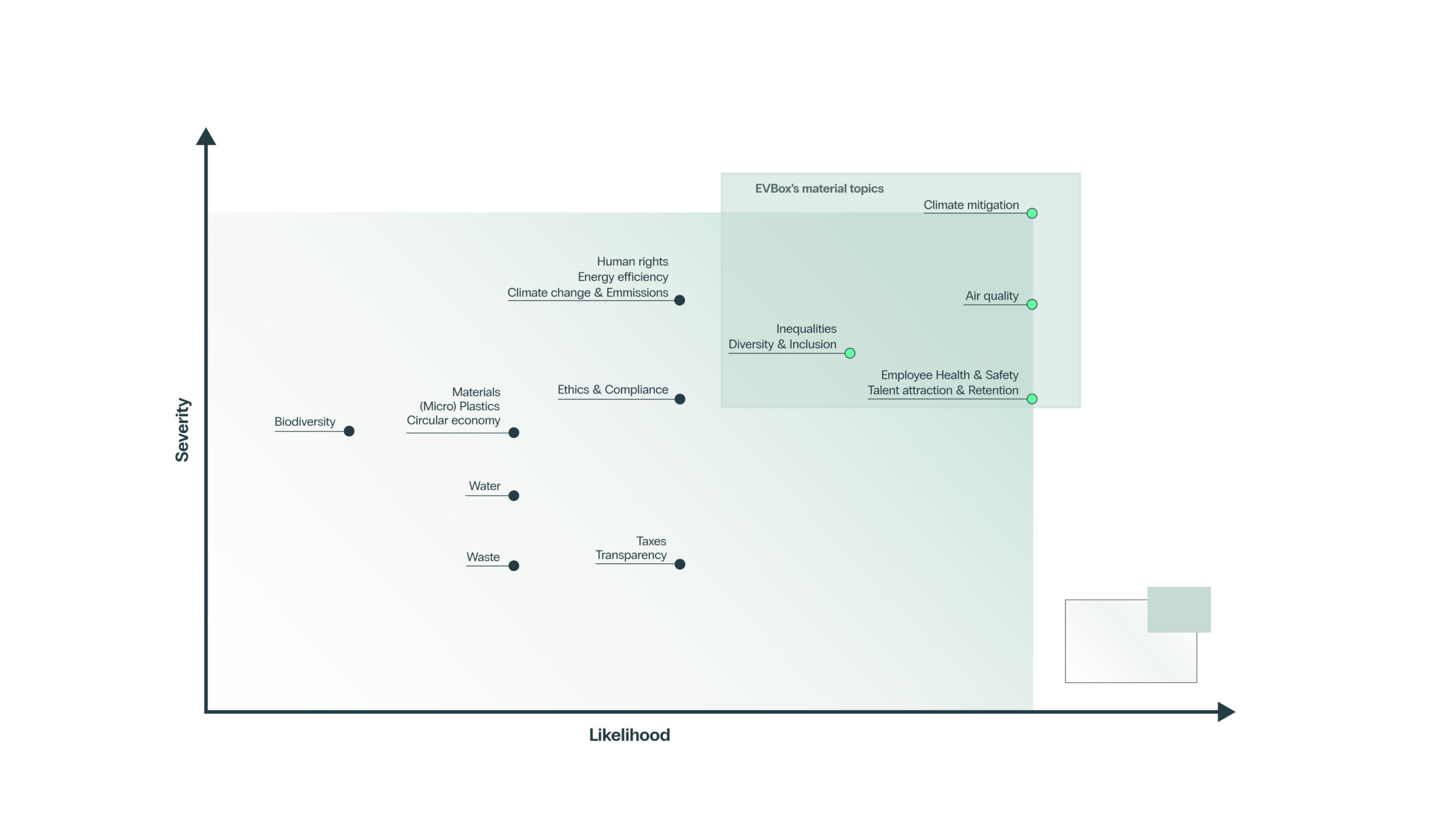EVBox’s 2022 double materiality assessment
The 2022 double materiality assessment was conducted according to the GRI Universal standards of 2021, the Taskforce for Climate-related Financial Disclosure (TCFD)’s reporting framework on climate risks and considering future requirements from the Corporate Sustainability Reporting Directive (CSRD).
The double materiality assessment is bi-dimensional meaning EVBox’s operations can both affect and be affected by economic, environmental, and social topics. The process was conducted in three main steps: stakeholder dialogue, employee survey, and impact assessment through research.
Our approach to stakeholder engagement
We have identified our stakeholders by surveying the groups, organizations, and individuals that are either impacted by our company’s operations or have an impact on the company’s strategy and goal achievement.
Our stakeholders for our 2022 assessment included:
- EVBox’s Executive Management Team
- EVBox’s employees
- Existing and potential customers
- Competitors and industry (EV sector)
- (Potential) Shareholders
- Society/NGO
The stakeholder dialogue and impact assessment through survey and research resulted in an overview of positive and negative impacts. The potential negative and positive impacts were determined by the severity (scale and scope) and likelihood of the impact. For potential negative impact, the irremediable character was assessed too. All topics were assessed on a scale of 1 to 5.
As CSRD requires a double materiality assessment, the second part of the materiality assessment was a financial materiality assessment.
A sustainability topic is material from a financial perspective if it triggers financial effects on the organization by potentially generating risks or opportunities that influence or are likely to influence the future cash flows, and therefore the enterprise value of the undertaking in the short, medium or long term but are not captured by financial reporting at the reporting date. See EFRAG’s Double Materiality Guidelines here.
The analysis of (potential) risks was an input for the general risk assessment at EVBox.
The most important subjects in the financial materiality assessment in 2022 were consequences of the Russian invasion of Ukraine, the energy crisis in Europe, the EU Taxonomy, the European Green Deal, climate targets, and emission reduction activities. Nature-related risks and human rights are other topics that have increased attention among our stakeholders.
See the results of EVBox’s 2022 materiality assessment in the below graphs.
Management of our material topics
Our general management approach assigns the Corporate Social Responsibility (CSR) & Sustainability team to address, monitor, and manage the material topics. They will address and follow up on material topics and initiate processes aimed at developing policies, actions, and goals within each topic.
At EVBox, the CSR & Sustainability team reports to the Senior Vice President of Strategic Enablement and Chief Executive Officer (CEO).
Specific goals and KPIs linked to the material topics are evaluated by the Executive Management Team (EMT).
The EMT evaluates the objectives and strategies. EVBox’s Governance Risk Compliance committee (GRC) evaluates risk profiles, mitigation plans, and progress.
Reporting
The materiality assessment 2022 was a part of EVBox’s voluntary reporting. For EVBox, mandatory reporting applies as of 2026 for 2025 results as per the CSRD.
Materiality assessment – Positive impact

Materiality assessment – Negative impact

Our 2022 materiality assessment resulted in 12 material topics as shown above. Out of these, four topics were scored the highest and identified as a priority for EVBox. Learn more about EVBox’s materiality topics and ambitions on our Sustainability page.
Materiality assessment – Financial impact
Potential risks after financial impact materiality assessment:
Disruption in supply chain:
- Price volatility – raw materials (Due to climate change, loss of biodiversity, resource scarcity)
- Raw materials unavailability (Due to climate change, loss of biodiversity, resource scarcity)
EU and national legislation:
- Noncompliance with EU and national legislation on GHG emissions (E.g. Paris Agreement)
- Noncompliance with EU and national legislation on Circular Economy (E.g. requirements on recycled content, enhanced producer responsibility)
Market:
- Price volatility (renewable) energy
- Consumption decreases/ turnover decreases due to inflation
